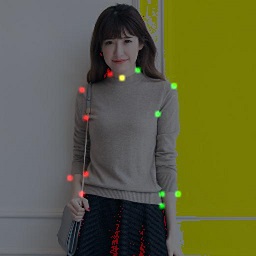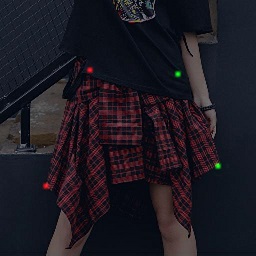HiKapok / Tf.fashionai
Programming Languages
Projects that are alternatives of or similar to Tf.fashionai
Hourglass, DHN and CPN model in TensorFlow for 2018-FashionAI Key Points Detection of Apparel at TianChi
This repository contains codes of the re-implementent of Stacked Hourglass Networks for Human Pose Estimation, Simple Baselines for Human Pose Estimation and Tracking (Deconvolution Head Network) and Cascaded Pyramid Network for Multi-Person Pose Estimation in TensorFlow for FashionAI Global Challenge 2018 - Key Points Detection of Apparel. Both the CPN(Cascaded Pyramid Network) and DHN (Deconvolution Head Network) here has several different backbones: ResNet50, SE-ResNet50, SE-ResNeXt50, DetNet or DetResNeXt50. I have also tried Averaging Weights Leads to Wider Optima and Better Generalization to ensemble models on the fly, although limited improvement was achieved.
The pre-trained models of backbone networks can be found here:
Introduction
The main goal of this competition is to detect the keypoints of the clothes' image colleted from Alibaba's e-commerce platforms. There are tens of thousands images in total five categories: blouse, outwear, trousers, skirt, dress. The keypoints for each category is defined as follows.
Almost all the codes was writen by myself and tested under TensorFlow 1.6, Python 3.5, Ubuntu 16.04. I tried to use the latest possible TensorFlow's best practice paradigm, like tf.estimator and tf.layers. Almost none py_func was used in my codes to maximize the performance. Augumentations like flip, rotate, random crop, color distort were used to reduce overfitting. The current performance of the model is ~0.4% in Normalized Error and got to ~20th-place in the second stage of the competition.
About the model:
- DetNet is better, perform almost the same as SEResNeXt, while SEResNet showed little improvement than ResNet
- DHN has at least the same performance as CPN, but lack of thorough testing due to the limited time
- Enforce the loss of invisible keypoints to zero gave better performance
- OHKM is useful
- It's bad to do gaussian blur on the predicted heatmap, but it's better to do gaussian blur on the target heatmaps for lower-level prediction
- Ensemble of the heatmaps for fliped images is worser than emsemble of the predictions of fliped images, and do one quarter correction is also useful
- Do cascaded prediction on whole network can eliminate the using of clothes detection network as well as larger input image
- The native hourglass model was the worst but still have great potential, see the top solution of here
There are still other ways to further improve the performance but I didn't try those in this competition because of their limitations in applications, for example:
- More larger input image size
- More deeper backbone networks
- Locate clothes first by detection networks
- Multi-scale supervision for Stacked Hourglass Models
- Extra-regressor to refine the location of keypoints
- Multi-crop or multi-scale ensemble for single image predictions
- It's maybe better to put all catgories into one model rather than training separate ones (the codes supports both mode)
- It was also reported that replacing the bilinear-upsample of CPN to deconvolution did much better
If you find it's useful to your research or competitions, any contribution or star to this repo is welcomed.
Usage
-
Download fashionAI Dataset and reorganize the directory as follows:
DATA_DIR/ |->train_0/ | |->Annotations/ | | |->annotations.csv | |->Images/ | | |->blouse | | |->... |->train_1/ | |->Annotations/ | | |->annotations.csv | |->Images/ | | |->blouse | | |->... |->... |->test_0/ | |->test.csv | |->Images/ | | |->blouse | | |->...DATA_DIR is your root path of the fashionAI Dataset.
- train_0 -> [update] warm_up_train_20180222.tar
- train_1 -> fashionAI_key_points_train_20180227.tar.gz
- train_2 -> fashionAI_key_points_test_a_20180227.tar
- train_3 -> fashionAI_key_points_test_b_20180418.tgz
- test_0 -> round2_fashionAI_key_points_test_a_20180426.tar
- test_1 -> round2_fashionAI_key_points_test_b_20180530.zip.zip
-
set your local dataset path in config.py, and then run convert_tfrecords.py to generate *.tfrecords
-
create one file foler named 'model' under the root path of your codes, download all the pre-trained weights of the backbone networks and put them into different sub-folders named 'resnet50', 'seresnet50' and 'seresnext50'. Then start training(set RECORDS_DATA_DIR and TEST_RECORDS_DATA_DIR according to your config.py):
python train_detxt_cpn_onebyone.py --run_on_cloud=False --data_dir=RECORDS_DATA_DIR python eval_all_cpn_onepass.py --run_on_cloud=False --backbone=detnext50_cpn --data_dir=TEST_RECORDS_DATA_DIR
Submit the generated 'detnext50_cpn_sub.csv' will give you ~0.0427
python train_senet_cpn_onebyone.py --run_on_cloud=False --data_dir=RECORDS_DATA_DIR python eval_all_cpn_onepass.py --run_on_cloud=False --backbone=seresnext50_cpn --data_dir=TEST_RECORDS_DATA_DIR
Submit the generated 'seresnext50_cpn_sub.csv' will give you ~0.0424
Copy both 'detnext50_cpn_sub.csv' and 'seresnext50_cpn_sub.csv' to a new folder and modify the path and filename in ensemble_from_csv.py, then run 'python ensemble_from_csv.py' and submit the generated 'ensmeble.csv' will give you ~0.0407.
-
training more deeper backbone networks will give better results (+0.001).
-
the training of hourglass model is almost the same as above but gave inferior performance
Results
Some Detection Results (satge one):
- Cascaded Pyramid Network:
- Stacked Hourglass Networks:
Apache License 2.0











